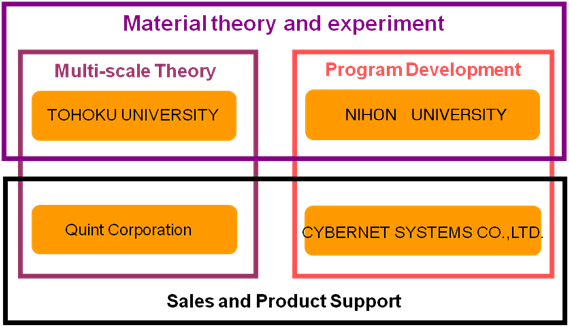![]()
Multiscale.Sim is a customized product that based on the multi-physics analysis tool "Ansys," and provides the equivalent property values as the homogenization method that is based on the numerical material test. Also, it provides the multi-scale analysis feature that is required for micro/macro structure linking analysis such as the macro model analysis to the localized analysis.
Material property values are calculated by numerical material test of micro structure without material tests that were required conventionally, by utilizing Multiscale.Sim. The results enable prediction of the macroscopic behavior by the macro structural analysis. Further, it is possible to predict the microscopic behavior by going back to the micro structure analysis again.
Multiscale Analysis flow
|
 |
Analysis Features
Linear Version
The Linear version can perform the following analysis based on the homogenization method.
- Elastic Analysis: Elastic modulus, Poisson's ratio, Shear elastic modulus, Linear expansion coefficient, Density
- Heat Transfer Analysis: Thermal conductivity, Specific heat
- Penetration Analysis: Permeability for Darcy's law
- Electric Current Analysis: Electrical resistivity
- Electric Field Analysis: Specific permittivity
- Magnetic Field Analysis: Specific magnetic permeability
Non-Linear Version
The non-linear version can perform the following analysis in addition to the above.
- Homogenization Analysis (numerical material test): Elasto-plasticity, Creep, Hyper-elastic, viscoelastic, Piezo-electric, Damage
- Homogenization Analysis (physical properties identified): Elasto-plasticity, Creep, Hyper-elastic, viscoelastic
- Localization: geometric non-linear, non-linear material (Elasto-plasticity, Creep, Hyper-elastic, viscoelastic)
Development and Sales Framework
CAE tool "Multiscale.Sim" uses the homogenization method which is one method of multi-scale modeling, and is jointly developed by three companies, Cybernet Systems Co.,Ltd., Nitto Boseki Co.,Ltd., and Quint Corporation by receiving cooperation from Professor Kenjiro Terada of Tohoku University. The official release date was June 25, 2007.

License / operating environment
- Windows 10, Windows 11
- Red Hat Linux 7.3*, SUSE Linux 12* (License Manager only). If you are using a different Linux version, please contact technical support.
- Ansys Workbench environment, Ansys Mechanical APDL (Previous Classic) environment
- The following licenses of Ansys are Supported(※)
※If you are using an Ansys Academic license, the analysis scale will depend on the mesh scale that is available on your product.
|
The type of Ansys license required for each analysis feature |
|
|
Mechanical Pro |
Mechanical |
Mechanical |
|
|
Elastic Coefficient |
○ |
○ |
○ |
|
|
Thermal Conductivity |
○ |
○ |
○ |
|
|
Coefficient of Linear Expansion |
○ |
○ |
○ |
|
|
Permeability Coefficient |
○(*1) |
○(*1) |
○(*1) |
|
|
Density |
○ |
○ |
○ |
|
|
Specific Heat |
○ |
○ |
○ |
|
|
Permittivity |
× |
× |
○ |
|
|
Magnetic Permeability |
× |
× |
○ |
|
|
Electrical Resistivity |
× |
× |
○ |
|
|
Numerical Material Test |
Elasto-plasticity |
× |
○ |
○ |
|
Hyper-Elastic |
× |
○ |
○ |
|
|
Viscoelastic |
× |
× |
○ |
|
|
Creep |
× |
× |
○ |
|
| Piezo-Electric | × | × | ○ | |
| Damage | × | × | ○ | |
|
Localized |
Linear |
○ |
○ |
○ |
|
Geometric Non-linear |
× |
× |
○ |
|
|
Non-linear Material |
× |
× |
○ |
|
|
Homogenization |
Elasto-plasticity |
× |
× |
○ |
|
Hyper-elastic |
× |
× |
○ |
|
|
Viscoelastic |
× |
× |
○ |
|
|
Creep |
× |
× |
○ |
|
Notes:
Features in red X are supported in the Ansys Mechanical APDL environment (Previously Classic) as well as in the Workbench environment.
(*1) Localization Analysis is not supported
Contact us for more information and support.
